Chevy’s second smallest car is also, as it turns out, one of its roomiest.
It’s also less than half the price of Chevy’s smallest car – the Bolt electric car – and it goes twice as far, without having to wait nearly as long.
This explains why GM (via the government) needs to pay people to buy the Bolt.
The Sonic relies on no such inducements.
It sells itself.
The Sonic is Chevy’s entry-level subcompact sedan/five-door hatchback.
It’s slightly larger than the electric Bolt – which is Chevy’s smallest car and (like several other non-electric rivals, including the Hyundai Accent) sold in sedan form only.
The Sonic is also much more affordable than the Bolt – which stickers for $37,495 to start – or about what you’d spend to buy a loaded Camaro SS, which isn’t electric but offers much better performance and goes a lot farther on a tankful than the Bolt can travel on a charge.
Prices for the Sonic start at $16,295 for the base trim sedan with manual transmission and top out at $21,520 for a five-door hatchback Premier trim with the automatic transmission.
The hatchback version has nearly three times the cargo room of the sedan (47.7 cubic feet vs. 14.9 cubic feet) as well as easier access to that space because of the liftgate vs. trunk and because the cargo area is an integral part of the passenger compartment.
WHAT’S NEW
The formerly optional 1.4 liter turbocharged engine that used to come with the sporty RS trim is now standard equipment across the Sonic line – and a six-speed manual transmission replaces the five-speed manual transmission that was standard last year.
This transmission has two overdrive gears – fifth and sixth – which (along with the more efficient 1.4 liter engine) accounts for a roughly 5 MPG uptick overall vs. last year’s Sonic with the previously standard 1.8 liter engine and five-speed transmission.
WHAT’S GOOD
Standard turbocharged engine is peppier than rivals’ non-turbo’d engines – and just as easy on gas.
Two bodystyles – sedan or hatchback.
Subcompact footprint – interior room and trunk size of a mid-sized car.
$1,000 price uptick vs. last year. You’re paying more for the now-standard 1.4 liter turbo engine and the new six-speed transmission.
No more option to go with the mechanically simpler (as well as less expensive) 1.8 liter no-turbo engine.
Rivals like the Hyundai Accent sedan cost less to start (base price $14,995) and deliver about the same MPGs. Honda Fit costs about the same ($16,190 to start) and offers even more room in a package about the same size.
The previously optional 1.4 liter turbocharged engine is now the Sonic’s standard – and only available – engine for 2019.
Upside: This engine produces significantly more low-end power than the formerly standard 1.8 liter engine, markedly improving the car’s acceleration without imposing a mileage cost.
The 1.4 liter engine makes exactly the same 138 horsepower as the old 1.8 liter engine but 148 ft.-lbs. of torque at just 1,850 RPM vs. 125 ft.-lbs. at 4,850 RPM.
This is why the ’19 Sonic can accelerate to 60 in a speedy (for an entry-level economy car) 8.2 seconds while the ’18 Sonic with the 1.8 liter engine needed 9.3 seconds to make the same run.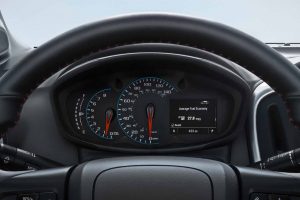
Also: The ’19 achieves an EPA-rated 28 MPG city, 37 MPG highway with the new six-speed manual transmission – a very noticeable improvement over the ’18 Sonic 1.8/five-speed manual’s mediocre 25 city, 33 highway.
The ’19 Sonic’s upticked mileage also matches the MPGs of less powerful (and peppy) rivals like the Hyundai Accent sedan (28 city, 37 highway) while the more powerful engine makes it much quicker than the Honda Fit, which takes ten seconds to get to 60.
On the downside, the $1,000 price uptick vs. last year rubs out the mileage gains – at least, until you’ve driven a lot of miles. Chevy – and the rest of the car industry – is bear-hugging smaller and smaller engines goosed by turbos to improve the MPGs – no matter how much it costs us.
But the car is at least quicker.
The other downside is that the 1.4 liter engine is pressurized. That’s what a turbo does – and it means the engine has to work harder to make power – and harder-working engines generally don’t last as long as those that don’t have to work as hard.
This is a general potential problem with all turbocharged cars – but turbocharged economy cars have an additional potential problem. It’s one thing to spend say $1,500 to replace a cooked turbo in a ten-year-old car that’s still worth $10k. But a car like the Sonic hasn’t got as much depreciation cushion. Pick one up today for $15k (after haggling) and ten years from now, it might be worth $5k – at which point it is hard to justify putting $1,500 in it for a new turbo.
But, you will enjoy that extra speed for as long as the turbo lasts.
Which – fingers crossed – might be as long as the car does.
And while you had to pay an extra grand this year, you still paid about fifteen grand less than you’d spend to get into the Bolt electric car. Which is only slightly speedier (0-60 in about 7 seconds) and (best case) only goes 238 miles before it exhausts its battery power and then has to be plugged in for at least 30-45 minutes to recover a partial charge.
The car press has been derelict in pointing out this fact of battery chemistry to potential buyers. High-voltage “fast” chargers can damage an EV’s battery pack, which is why recharges on these “fast” chargers is limited to 80 percent of the battery pack’s capacity – which means you lose 20 percent of the advertised “best case” range.
Thus, the Bolt’s touted 238 mile range is really more like 190 miles – or about half as far as the Sonic can go on a full tank.
And the Sonic – unlike the Bolt – can be refueled to full in just a couple of minutes.
Cars in this class are designed chiefly to be inexpensive and fuel-efficient, but the Sonic adds some driving fun to the mix.
Turbocharging used to be a power-adder for already peppy cars to make them even more so – with a mileage loss accepted for the sake of improved acceleration. The Sonic gives you the extra pep without the penalty at the pump.
The turbo also really helps the automatic-equipped Sonic get going – once again, because of the torque. A small engine without a turbo that doesn’t make a lot of torque in the low and mid-range can at least be revved to the sweet spot of its powerband, the clutch slipped and off you go . . .
If you have a manual transmission.
With an automatic, acceleration is often tepid without the torque-assist of the turbo. It’s the price you pay for the convenience of not having to shift in traffic. But you don’t pay that price here. There is enough torque on tap to spin the tires, even – and that’s fun, too.
Also, it’s agile – because it’s got such a small footprint.
The short wheelbase (99.4 inches) and overall length (173.9 inches) not only makes it easy to slot into tight spots, it gives it a tight (34.5 inch) turning radius. Which makes it an ideal city/commuter car that’s not out of its depth on the highway.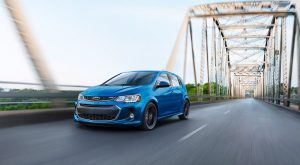
The Sonic’s chief negative is the obnoxious auto-stop/start system (ASS – though that’s not the acronym anyone uses although they should) which constantly cycles the engine off and on and off an on . . . at every red light or halt of traffic.
ASS is standard and while it can be turned off, you have to turn it off every time you go for a drive or it will turn the engine off at the first red light.
Almost no one wants ASS (this kind of ASS) but ASS is becoming de facto standard equipment in new cars because the government wants it. ASS slightly improves gas mileage – maybe by 1 MPG overall.
No matter how much it costs us.
It’s becoming harder to find entry-level subcompacts offered in more than one bodystyle, which gives the Sonic and edge because it is available in two bodystyles.
And both are roomier than others in the class – as well as more versatile.
If you pick the sedan, you’ll get a 14.9 cubic foot trunk – nearly as much trunk space as several current mid-sized sedans, which are two sizes larger than the Sonic on the outside.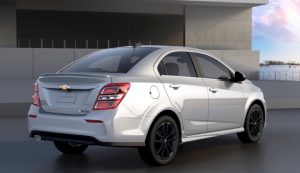
If you go with the five-door hatchback, you’ll get 47.7 cubic feet of cargo capacity with the second row seats folded flat. That’s comparable to the cargo capacity of several small crossover SUVs, but at a lower price point and with the option to select a manual transmission if you like.
Almost all 2019 crossovers are automatic-only.
Either way – sedan or hatchback – you’ll get an exceptionally roomy backseat, with 34.6 inches of legroom.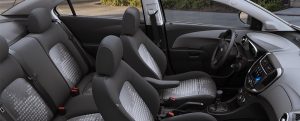
This is more than the Hyundai Accent’s got (33.5 inches) and the Accent is only sold as a sedan (with a 13.7 cubic foot trunk).
The Kia Forte – another possible cross-shop – has a slightly roomier back seat (35.9 inches) and the same size trunk – as well as more powerful standard engine (147 horsepower). But it’s also only offered in sedan form and its base price ($17,690) is proportionately (by about $1,400) a lot higher than the Chevy’s.
The Honda Fit is the most space-efficient car in the segment – with a 16.6 cubic foot trunk and 52.7 cubic feet of total cargo capacity. But it’s also one of the slowest cars in the segment.
The Sonic is very well-appointed – even the base trim. All come standard with a 7-inch LCD touchscreen and 4G in-car WiFi, ten air bags and most power options.
You can get unusual-for-the-class (and price) features such as a heated steering wheel and remote engine start, too.
Also, the car comes standard with 15-inch wheels, which means softer/smoother/quieter-riding and less expensive to replace 15-inch tires.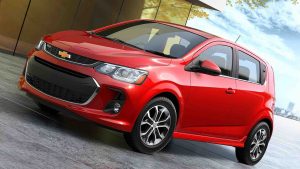
The Rally Sport package is still available (and standard with the hatchback) but it’s now entirely cosmetic.
It includes that includes piano black interior trim, leather-wrapped Sport steering wheel and an exterior body kit with a decklid spoiler.
THE BOTTOM LINE
The Sonic is a small car that’s bigger inside than you’d expect – and now under the hood, too.
. . .
Got a question about cars – or anything else? Click on the “ask Eric” link and send ’em in!
If you like what you’ve found here please consider supporting EPautos.
We depend on you to keep the wheels turning!
Our donate button is here.
If you prefer not to use PayPal, our mailing address is:
EPautos
721 Hummingbird Lane SE
Copper Hill, VA 24079
PS: Get an EPautos magnet (pictured below) in return for a $20 or more one-time donation or a $5 or more monthly recurring donation. (Please be sure to tell us you want a sticker – and also, provide an address, so we know where to mail the thing!)
My latest eBook is also available for your favorite price – free! Click here. 


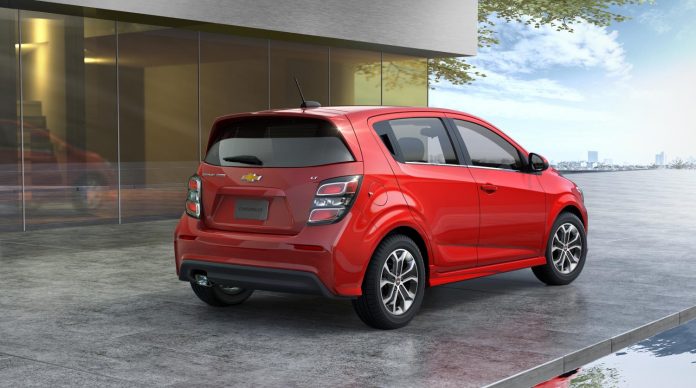


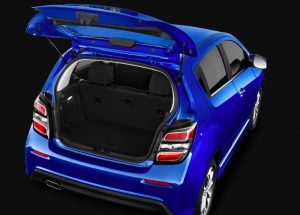
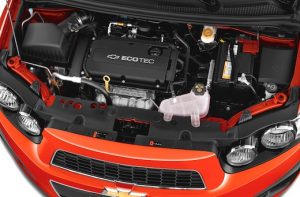

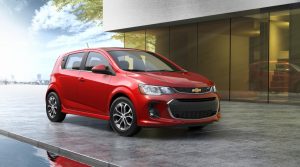
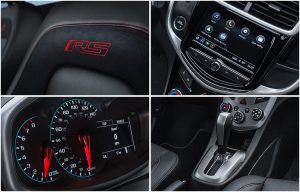








The 5 door is even shorter. That 173″ # is for the sedan.
And the 1.4 has a timing chain where the old standard 1.8 didn’t. Like the 15″ tires, another maintenance saving aspect.
Turning radius is remarkable. Same as my ION and 86 Olds Calais. IIRC the Mirage has a radius of 33.
It makes a difference. As important [to me] as rear leg room, visibility, mileage, size and head room.
Except for ASS, one of the few new cars I’d actually be interested in buying. And in manual form.
Plus it has an automatic that’s reliable, unlike the Fiesta.
Hi Bostwick,
People who know me know that as much as I like a fast car, I also like a fun car – and not all fast cars are fun and not all fun cars are fast!
A 6=speed manual and a timing CHAIN?! This is almost starting to sound decent! (But knowing GM, it’s still probably a pile of feces! Ciould they actually be having a brief moment of sanity?))
Who THE HELL would buy a Chevy, when they could get a freaking HONDA for the same price??!!!!
In 5 years, the Honda will be worth at least TWICE what the not-so-super Sonic will be worth- assuming the Sonic is even still running.
Only in America! Land of the feeb; home of the bray.
I’m that guy. I’d take this over a Fit. Mainly because I’ve only seen women driving the Honda, and this is less common. I’m all about exclusivity.
Yeah, but assuming that Honda is still holding up the quality, I’d rather drive the sissy car that’d last 250K miles and retain a lot more value, than the one that probably won’t make it to 100K, and’ll be worth 50% of it’s original price in 3 or 4 years.
The Honda makes sense, it’s me that doesn’t. I like oddball cars. Resale value and such are low on the totem pole for me. You’re a more sensible guy than myself.
Happy New Year! Hope you gentlemen have a good ’19
Thanks, Binny!
Lemme axk you this: When you bought the Sonic, did you know that the Honda could be had for the same price? (I wouldn’t have guessed that, if Eric hadn’t mentioned it in the article- but then again, I’m never in the market for a new car…)
Anyhoo, good luck with it. It’s actually not a bad looking car. My niece bought one about 2 years ago- and her fambly is hard on cars (They kill just about every car they get, well before 100K miles…but then maybe it’s because they always buy GM.. 🙂 ) and so far, hers is holding up pretty well.
Hey, just knowing you can still buy a car these days for $16K, and can even get it with a stick (!), that’s encouraging!
Nunzio,
I don’t own one of these. I can see where these sub-compacts would be a good choice for the college kids though. I bet GM is going to end up discounting these to make em cheaper than the Honda though.
Yeah, that 6 speed really jacks the value up in my book. Sounds like it might be fun to drive.
Hi Bin,
These little buggers aren’t quick, but the everyday troof is that most drivers aren’t – which makes them easy meat for one who is, even in a car like this!
GM lending you cars to drive again ???
Hi NI,
Not officially!
That 35 inch turning radius is quite small. Never seen one THAT small. LOL!!
It’s a lawnmower! 🙂
Wow, the Sonic is 2900lbs !!! crazy.
What am I missing? Strengthened frames to meet crash tests?
That’s what a 64 Chevelle with a small block weighed. That’s full body on frame midsize with a V8 and can carry 6 people and their luggage.
The cheapest hatchback is pushing 2,900 pounds, and is $18K. Let’s compare to the CRX article and see what we are missing.
Hi Anonymous,
That’s easy! About 15 MPG and about 1,000 lbs.
Plus, no got-damned air bags, no ASS, no nannyism – and good visibility, along with fun to drive!
“Fun to drive” nails it. My little boy loves spinning donuts in the snow. I have to drive my 96 Tacoma to do that if I don’t want to burn rear brakes and only have half the fun.
Just imagine the humanity of having to manually work the brakes in regular driving. You have to no be an idiot that knows how to drive. How scary it is to know how to drive a vehicle and operate everything manually. Shit, I’m just an old bastard at 39 years of age thinking that that’s okay.
I’m such a grumpy, irresponsible old bastard that I don’t even make my kids sit in a booster seat until they weigh 150 lbs or reach the age of 15 1/2–or whatever the the kremlin’s ridiculous regs are.